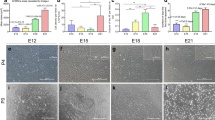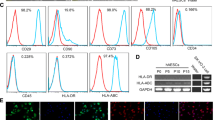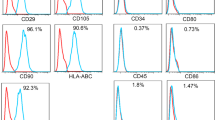Abstract
Although human amniotic fluid is an attractive source of multipotent stem cells, the potential of amniotic fluid stem cells (AFSCs) to differentiate into hepatic cells has not been extensively evaluated. In this study, we examined whether human AFSCs can differentiate into a hepatic cell lineage in vitro and in vivo. After being treated with cytokines (fibroblast growth factor 4, basic fibroblast growth factor, hepatocyte growth factor, and oncostatin), AFSCs developed a morphology similar to that of hepatocytes. RT-PCR and immunofluorescence analysis showed that the treated AFSCs expressed the hepatocyte-specific markers albumin, cytokeratin 18, and alpha-fetoprotein. The differentiated cells also developed hepatocyte-specific functions, i.e., they secreted albumin, absorbed indocyanine green, and stored glycogen. When transplanted into CCl4-injured immunodeficient mice, undifferentiated AFSCs were integrated into the liver tissue, and they expressed markers characteristic of mature human hepatocytes. Although integration of AFSCs into the liver was limited (0.1–0.3% of hepatocytes), histological analysis showed that the recipient mice recovered more rapidly from CCl4 injury than CCl4-injured mice that did not receive AFSCs. AFSCs can differentiate into hepatocyte-like cells in vitro and in vivo and can represent an easily accessible source of progenitor cells for hepatocyte regeneration and liver cell transplantation.



Similar content being viewed by others
References
Bansal M. B.; Kovalovich K.; Gupta R. et al. Interleukin-6 protects hepatocytes from CCl4-mediated necrosis and apoptosis in mice by reducing MMP-2 expression. J. Hepatol. 42: 548–556; 2005.
Bouchereau M.; Gervais M. K.; Sideris L. et al. Hepatic necrosis and hemorrhage following hyperthermic intraperitoneal chemotherapy with oxaliplatin: a review of two cases. J. Gastrointest. Oncol. 2: 113–116; 2011.
Cai J.; Zhao Y.; Liu Y. et al. Directed differentiation of human embryonic stem cells into functional hepatic cells. Hepatology 45: 1229–1239; 2007.
Carraro G.; Perin L.; Sedrakyan S. et al. Human amniotic fluid stem cells can integrate and differentiate into epithelial lung lineages. Stem. Cells. 26: 2902–2911; 2008.
Chiavegato A.; Bollini S.; Pozzobon M. et al. Human amniotic fluid-derived stem cells are rejected after transplantation in the myocardium of normal, ischemic, immuno-suppressed or immuno-deficient rat. J. Mol. Cell. Cardiol. 42: 746–759; 2007.
Cipriani S.; Bonini D.; Marchina E. et al. Mesenchymal cells from human amniotic fluid survive and migrate after transplantation into adult rat brain. Cell. Biol. Int. 31: 845–850; 2007.
De Coppi P.; Bartsch Jr. G.; Siddiqui M. M. et al. Isolation of amniotic stem cell lines with potential for therapy. Nat. Biotechnol. 25: 100–106; 2007.
Gagandeep S.; Rajvanshi P.; Sokhi R. P. et al. Transplanted hepatocytes engraft, survive, and proliferate in the liver of rats with carbon tetrachloride-induced cirrhosis. J. Pathol. 191: 78–85; 2000.
Gang E. J.; Bosnakovski D.; Figueiredo C. A. et al. SSEA-4 identifies mesenchymal stem cells from bone marrow. Blood 109: 1743–1751; 2007.
Gupta S.; Rajvanshi P.; Irani A. N. et al. Integration and proliferation of transplanted cells in hepatic parenchyma following D-galactosamine-induced acute injury in F344 rats. J. Pathol. 190: 203–210; 2000.
Hay D. C.; Zhao D.; Ross A. et al. Direct differentiation of human embryonic stem cells to hepatocyte-like cells exhibiting functional activities. Cloning. Stem. Cells. 9: 51–62; 2007.
Henderson J. K.; Draper J. S.; Baillie H. S. et al. Preimplantation human embryos and embryonic stem cells show comparable expression of stage-specific embryonic antigens. Stem. Cells. 20: 329–337; 2002.
In’t Anker P. S.; Scherjon S. A.; Kleijburg-vanderKeur C. et al. Isolation of mesenchymal stem cells of fetal or maternal origin from human placenta. Stem. Cells. 22: 1338–1345; 2004.
Kaido T.; Yamaoka S.; Tanaka J. et al. Continuous HGF supply from HGF-expressing fibroblasts transplanted into spleen prevents CCl4-induced acute liver injury in rats. Biochem. Biophys. Res. Commun. 218: 1–5; 1996.
Kakinuma S.; Tanaka Y.; Chinzei R. et al. Human umbilical cord blood as a source of transplantable hepatic progenitor cells. Stem. Cells. 21: 217–227; 2003.
Kamada Y.; Yoshida Y.; Saji Y. et al. Transplantation of basic fibroblast growth factor-pretreated adipose tissue-derived stromal cells enhances regression of liver fibrosis in mice. Am. J. Physiol. Gastrointest. Liver. Physiol. 296: G157–G167; 2009.
Kim J.; Lee Y.; Kim H. et al. Human amniotic fluid-derived stem cells have characteristics of multipotent stem cells. Cell. Prolif. 40: 75–90; 2007.
Naugler W. Hepatocellular carcinoma: targeted therapy and multidisciplinary care—Kelly M. McMasters and Jean-Nicolas Vauthey, editors. J. Gastrointest. Oncol. 2: 122; 2011.
Nussler A.; Konig S.; Ott M. et al. Present status and perspectives of cell-based therapies for liver diseases. J. Hepatol. 45: 144–159; 2006.
Ochenashko O. V.; Nikitchenko Y. V.; Volkova N. A. et al. Functional hepatic recovery after xenotransplantation of cryopreserved fetal liver cells or soluble cell-factor administration in a cirrhotic rat model: are viable cells necessary? J. Gastroenterol. Hepatol. 23: e275–e282; 2008.
Ochenashko O. V.; Volkova N. A.; Mazur S. P. et al. Cryopreserved fetal liver cell transplants support the chronic failing liver in rats with CCl4-induced cirrhosis. Cell. Transplant. 15: 23–33; 2006.
Perin L.; Sedrakyan S.; Da Sacco S. et al. Characterization of human amniotic fluid stem cells and their pluripotential capability. Methods. Cell. Biol. 86: 85–99; 2008.
Sakai Y.; Jiang J.; Kojima N. et al. Enhanced in vitro maturation of fetal mouse liver cells with oncostatin M, nicotinamide, and dimethyl sulfoxide. Cell. Transplant. 11: 435–441; 2002.
Schmidt D.; Achermann J.; Odermatt B. et al. Cryopreserved amniotic fluid-derived cells: a lifelong autologous fetal stem cell source for heart valve tissue engineering. J. Heart. Valve. Dis. 17: 446–455; 2008.
Schwartz R. E.; Reyes M.; Koodie L. et al. Multipotent adult progenitor cells from bone marrow differentiate into functional hepatocyte-like cells. J. Clin. Invest. 109: 1291–1302; 2002.
Snykers S.; Vanhaecke T.; Papeleu P. et al. Sequential exposure to cytokines reflecting embryogenesis: the key for in vitro differentiation of adult bone marrow stem cells into functional hepatocyte-like cells. Toxicol. Sci. 94: 330–341; 2006.
Tsai M. S.; Lee J. L.; Chang Y. J. et al. Isolation of human multipotent mesenchymal stem cells from second-trimester amniotic fluid using a novel two-stage culture protocol. Hum. Reprod. 19: 1450–1456; 2004.
Yamada T.; Yoshikawa M.; Kanda S. et al. In vitro differentiation of embryonic stem cells into hepatocyte-like cells identified by cellular uptake of indocyanine green. Stem. Cells. 20: 146–154; 2002.
Yan Y.; Xu W.; Qian H. et al. Mesenchymal stem cells from human umbilical cords ameliorate mouse hepatic injury in vivo. Liver. Int. 29: 356–365; 2009.
Zheng Y. B.; Gao Z. L.; Xie C. et al. Characterization and hepatogenic differentiation of mesenchymal stem cells from human amniotic fluid and human bone marrow: a comparative study. Cell. Biol. Int. 32: 1439–1448; 2008.
Author information
Authors and Affiliations
Corresponding authors
Additional information
Editor: T. Okamoto
Rights and permissions
About this article
Cite this article
Liu, H., Liu, Dq., Li, Bw. et al. Human amniotic fluid-derived stem cells can differentiate into hepatocyte-like cells in vitro and in vivo. In Vitro Cell.Dev.Biol.-Animal 47, 601–608 (2011). https://doi.org/10.1007/s11626-011-9450-3
Received:
Accepted:
Published:
Issue Date:
DOI: https://doi.org/10.1007/s11626-011-9450-3




